I think I’m one of the few people who doesn’t care much for Out of the Past. It may be that for me the closer a movie gets to film noir, the less it appeals to me. I can’t argue with any of the superlatives used to describe this one. But despite all it does right in terms of noir, I can’t get terribly enthused.
When style beats the pants off of story
Among the many fascinating and, in this case, amazing things about The Maltese Falcon is that it was the first film for Sydney Greenstreet who was 62 years old at the time. Can you imagine any actor today getting a role, much less starting a career at 62?
High Sierra: When the bad guy is the good guy
I recently finished reading Stefan Kanfer’s Tough Without a Gun: The Life and Extraordinary Afterlife of Humphrey Bogart. (The title is from something Raymond Chandler said of Bogart.) So of course, I’m back to watching Bogart movies, at least for the time being.
A curious Long Goodbye from Robert Altman
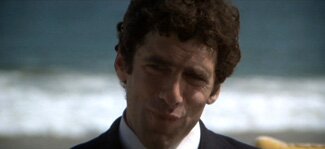
To be honest, I’ve never been a big Robert Altman fan, though increasingly I’m finding his movies more appealing. I think his approach creates the sense in me that I’m listening to a slow-talker and I want to interrupt and say, “Move it along; get to the point.” There’s an improvisational feel to character interaction and part of me want’s it more closely scripted and edited.
In The Long Goodbye this comes across partly because Altman gives his actors more responsibility to actually act, as he does with Elliott Gould here, and partly because the camera is constantly moving, as if you as a viewer are watching and trying to find a better vantage point. Some shots are through windows; some are even reflections in windows.
It’s intriguing, yet for me a bit irksome — but that’s just a personal, subjective thing. And what is odd about it is that I like this movie nonetheless.
 The Long Goodbye (1973)
The Long Goodbye (1973)
Directed by Robert Altman
Robert Altman’s The Long Goodbye is a bit like a fast food hamburger. It has beef in it but also has so many other things, and it has been altered to such a degree, that while it resembles a hamburger, it ain’t no hamburger.
In the same way, Altman’s movie is Raymond Chandler’s book, and resembles a film version of that book, but it ain’t Chandler’s book.
But then, you wouldn’t expect Altman to make a movie utterly faithful to its source.
Altman’s movie begins with the question, “What would happen if Marlowe, a character of the 40s and 50s, were to wake up and find himself in the early 70s?” In an interview, he says they referred to it as “Rip Van Marlowe” during the making of the movie. This idea dictates how the movie plays out.
Chandler’s Marlowe began in 1939 with The Big Sleep. His book The Long Goodbye was published in 1953. That is exactly twenty years before Altman’s The Long Goodbye.
Chandler’s Marlowe had been in about six books prior to the 1953 book. In The Long Goodbye, his Marlowe is older and mellower. The novel is a bit more reflective and, in my opinion, weighty. There is less emphasis on the tough guy posturing of the early books; he comes across as a more mature character. In some ways, there is a sense of alternating melancholy and apathy in him.
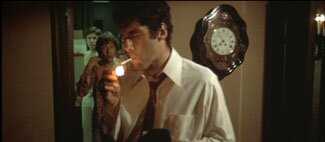
This may be what suggests the “Rip Van Marlowe” possibility to screenwriter Leigh Brackett and director Altman, or at least what makes this book a possible vehicle for working out that theme. However, there is more to the theme than just the “what if” aspect of a man from 1953 waking up in 1973. One thing that has changed for Marlowe is how people view friendship. The world has a different sense of ethics and morality and it isn’t in sync with his.
The movie opens with Philip Marlowe (Elliott Gould) literally waking up. The first half of the movie, particularly the first twenty minutes or so, give us such a slovenly, disconnected and half-asleep Marlowe that, the portrayal being so effective, he is incredibly annoying. He speaks under his breath, muttering to himself more than anyone else, even when responding to others around him. He’s almost completely unengaged with his world.
He shows no animation at all until his friend, Terry Lennox (Jim Bouton) shows up at his door. This is where the story’s engine turns over and it gets underway as Terry asks Marlowe to take him to Mexico.

The story makes some major turns from the Chandler book, some for the purposes of condensation and some … Perhaps because they didn’t want to make a movie faithful to its source but one that stood on its own legs as unique.
Having re-read the book recently (which is probably why I keep referring back to it), and it being my favourite of the Chandler novels, I can’t say I like the deviations. I found the book had more meaning for me than the movie largely because of those things that have been changed, though I do like the movie on its own merits.
But the book’s ending is much more effective and moving, I think. The movie is very direct – you can’t miss its point. In a way, it’s like Altman believes he has to be direct because people in 1973 are as much asleep as Marlowe was. His conclusion is like a bucket of cold water in the face.
The “asleep” idea recurs through the movie. It’s not just Marlowe who is somnambulant. His neighbours, the young women with their yoga and exercise, appear to be lost in their own world of new age exercise and spirituality. Roger Wade (Sterling Haydon) is lost in his alcohol and self-pity. Everyone is self-absorbed and inward looking and Marlowe is the one person who “wakened” to this contagion of social sleepwalking.
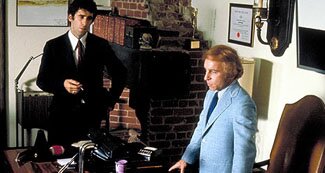
Marlowe “wakes up” because something has wakened him: the death of his friend Terry Lennox. He remains true to his friend, though for all intents and purposes it’s meaningless, isn’t it? (Terry is dead, after all.) Yet Marlowe won’t believe the murder and suicide that are being attributed to his friend.
No one else in the movie is true to anyone or anything. Even Marlowe’s cat abandons him when its favourite food is no longer there. Marty Augustine (Mark Rydell) speaks of how much he loves his girlfriend then strike her horribly for no reason. Roger Wade hits his wife when he is drunk.
Throughout the movie, as Marlowe makes his way, he sees a world of self-interest and no loyalty, making him an anachronism. When asked why he would try to clear the name of Terry Lennox, he hears variations of, “What’s it matter? He’s dead.”
The ending aside, this is probably the greatest deviation from the novel. In the book, respect and loyalty keep appearing – Marlowe is hired for his; the gangsters in the book (unlike the Marty Augustine character) respect Marlowe for his loyalty. Even some of the cops do. He is sought out and hired because it’s reported in the newspapers that he was picked up by the police for questioning and wouldn’t talk.
So the difference in the endings becomes a bit curious. Is it simply a more overt, can’t-miss-that meaning concerning betrayal of a friendship or is it also suggesting that Marlowe, too, is becoming part of that amoral culture of self-centeredness?
I’m not really sure. But I do know this is a curious movie Robert Altman has given us.
A good time had by all
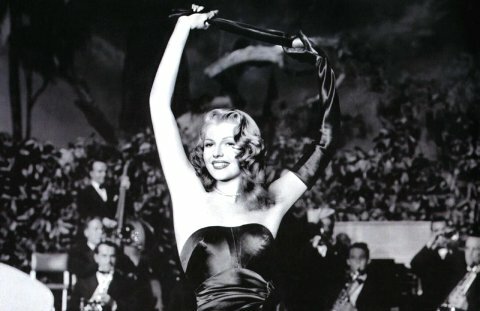
The 2011 version of the For the Love of Film blogathon has wrapped, this year with a focus on film noir. This post is slightly belated given that the last day was Monday.
This year, as last, it was carried out thanks to the efforts of Ferdy on Films and the Self-Styled Siren. Have a look at their blogs for their blogathon wrap-ups, oodles of links to wonderful posts on the subject of film noir from the Interent, and a thank you message from Eddie Muller, president of the Film Noir Foundation. It reads in part:
“Passion is sacred. Thanks to everyone for sharing their passion this past week. Let’s keep carrying the torch, not only for our favorite art form, but for all the things we cherish and refuse to relinquish.”
As for myself, in some ways I’ll be glad to move on to something other than noir while on the other hand I’m going to miss the enthusiasm the past week has been filled with. And maybe I won’t move on to another genre just yet because I’ve enjoyed this so much. I managed to scribble about seven film noirs movie during the blogathon:
- The Hot Spot (1990)
- Gilda (1946)
- Dark Passage (1947)
- Chinatown (1974)
- Anatomy of a Murder (1959)
- I Wake Up Screaming (1941)
- This Gun For Hire (1942)
Of those, in the interests of variety I posted about one I didn’t think was a particularly good movie (Dark Passage) and one that probably isn’t the first movie to pop into your head when the term noir is used (The Hot Spot).
But of them all the one I found myself thoroughly caught up with as far as thinking about it, Gilda is the easy winner. For two days after having watched it yet again (I’ve seen it many times over the years), I kept musing about it. Despite having seen it many times, it was the first time I had thought of it as a portrait of an abusive relationship, which is really what the movie is.
Anyway … though the blogathon is over, I’m pretty sure you can still . So please do so. You can use the link in the right hand column.
Now it’s time to backtrack and catch up on all the posts others have written on the subject of film noir that I have yet to get to!
Film noir means B-movies like The Hot Spot
The Final Day of For the Love of Film (Noir) — Please or use the button on the right. If you’ve considered it but have put it off, now is the time. If you are interested in boatloads of great links to musings on film noir and its films, scroll down the page at Self-Styled Siren or over at Ferdy on Films. This is wonderful material!
Best known as an actor, Dennis Hopper also directed movies — eight, I believe, including the well known Easy Rider. Hopper never set the world alight as a director, but in 1990 he made a pretty good film noir called The Hot Spot. (The movie’s poster does a bit of over-selling with the words, “Film noir like you’ve never seen.”)
It’s a good example of a certain kind of neo-noir. As a genre, noir returns again and again because it tells a certain kind of story in a certain way. In The Hot Spot, you sense this is why Hopper is doing a film noir. On the other hand, you can see a neo-noir like the Coens’ The Man Who Wasn’t There and view a film that chooses the genre for the same reason but also for its style — in the Coen’s case, it’s a puzzling mix of homage and parody.
The Hot Spot is really just about its story: corruption. It’s not a great movie; it’s average. Still, it’s engaging and in some ways more true to noir for that reason (and what I assume was likely a comparatively small budget). It’s made as a B-movie and looks and feels like a B-movie. Here’s the review I wrote of it about ten or so years ago. ( There may be spoilers ahead, explicit and implicit.)
The Hot Spot (1990)
Directed by Dennis Hopper
“I found my level. And I’m livin’ it.”
This is a pretty good film noir from 1990 directed by Dennis Hopper. For some reason The Hot Spot seems to dwell in the undeserved province of obscurity. Yet it has all the noir elements, presents them well, and resolves itself in a fashion that would please Alfred Hitchcock.
It stars Don Johnson as a drifter – we never learn much about who he is, his past, or much background to support his motivation. But this doesn’t matter; in fact, it actually works for the film since it helps create a sense of mystery.
It also leaves you never quite sure about whether he’s a good guy or a bad guy.
He wanders into a sweltering “nothing-ever-happens-here” small town to get his car repaired then takes a job as a car salesmen as he waits. While waiting, he also checks out the lay of the land. What he finds is a dull town anxious for something, anything, to happen.
It’s the tedium of the town that has generated its odor of corruption and you can’t help feeling that the catalyst behind all the avarice and moral decay is simply boredom.
While in the town, Johnson’s character sees what appears to be an easy opportunity to rob the local bank and, seeing this, he immediately begins planning to do so. Script, acting and direction work well here as it is never explicitly stated that this is what he is planning; it’s communicated through selected shots, angles, and facial expressions. In fact, while you suspect this may be what he is up to you are never quite sure.
The other two principle characters in the film are Virginia Madsen as a slatternly, greedy wife and Jennifer Connelly as a young, innocent woman who is being blackmailed (despite the apparent contradiction in that).
Compounding the problems for Johnson’s character are the relationships he forms with these women. It reflects the conflict within Johnson’s character between doing what is right and doing what is wrong: in Madsen, he recognizes a similarly corrupt soul and while he is attracted to her he is also repelled. It is as if he sees himself in her and it generates a kind of self-contempt that he expresses through his contempt of her.
In Connelly’s character, he sees what he has lost and wants to get back: a sense of innocence and goodness. Through her, he sees the man he would like to be (as opposed to Madsen’s character which shows him what he feels he is and wants to leave behind). This is the essential conflict in the story, a moral one. It drives the story. Which way will Johnson’s character ultimately go?
The story and Hopper’s directing lay a seamy, sultry tone over the entire film. It is sexy in a sluttish way; an air of corruption hangs over everything. With the exception of Connelly’s character, everyone is an aspect of moral decay. Everyone is motivated by base interests, even Johnson’s character though he is the only one struggling with it.
While not stylish in the way the Coen’s The Man Who Wasn’t There is, The Hot Spot is probably a better example of noir. (This doesn’t mean it is a better movie; just a better example.) It is better in the sense that where the noir feeling in the Coen’s film is communicated through angles, lighting and other technical and stylistic elements, in Hopper’s film it is the story, characters and performance that make this noir. It’s not a brilliant film by any means, but it is damn good. Where a movie like The Man Who Wasn’t There looks like film noir, The Hot Spot feels noir – and that is what noir is. Feeling. Mood.
If I have a quibble with the movie it would be it’s length. It probably should have trimmed about 20 or 30 minutes. After all, most of the film noirs that originated the genre ran between 70 and 90 minutes.
(By the way, there are no points for the movie’s title. It’s pretty unimaginative. It’s also the same title I Wake Up Screaming would have had if the studios had had their way. Fortunately, the actors objected and they went with the original title.)
Abuse never looked as beautiful as it does in Gilda
It’s Day 7 of For the Love of Film (Noir) — don’t forget to or use the button on the right. We’re near the end, so now is the time to donate if you haven’t already. If you are interested in boatloads of great links to musings on film noir and its films, scroll down the page at Self-Styled Siren or over at Ferdy on Films. This is wonderful material!
As much attention as Gilda gets for the beauty and sexiness of Rita Hayworth, what always strikes me is what a mean-spirited, spiteful bastard Glenn Ford is as Johnny Farrell. For about ninety percent of the movie he is abusive and hateful.
Being on the receiving end of it all, Hayworth’s Gilda is a beautiful cry for help. Intentional or not, this movie is a portrait of abuse: verbal, psychological and physical.
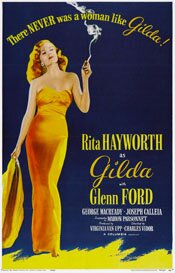 Gilda (1946)
Gilda (1946)
Directed by Charles Vidor
The opening of Gilda may be the perfect image for film noir. The camera tilts up from ground level revealing Glenn Ford as Johnny Farrell. He is on his hands and knees, disheveled, hair hanging down over his eyes, as he determinedly rolls his dice.The camera angle makes those dice look huge.
It is almost as if Ford is on the ground groveling.
Compare that to all the heroic shots of John Wayne in those innumerable westerns. Noir and westerns are two sides of one coin, the hero. Being noir, however, the hero must have his femme fatale to muddle up the works for him.
Inevitably, we soon encounter Rita Hayworth as Gilda.
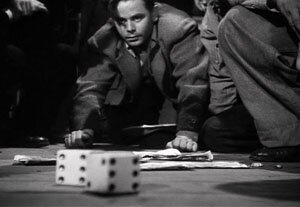
What we soon learn about Johnny and Gilda is that they are really just small time people scrambling to make it in a less than friendly world. Neither really has any admirable characteristics, at least not through most of the movie. (At one point Gilda says, “If I’d been a ranch, they would have called me the Bar Nothing.”)
Yet somehow, for some reason, we’re on their side. Maybe it’s because in the world they inhabit they are slightly better than the other characters and we side with them because we identify with the struggles and compromises made to live in the world.
I’m always fascinated by the dichotomy of westerns and noirs and the idea that they are one thing seen from opposing angles.
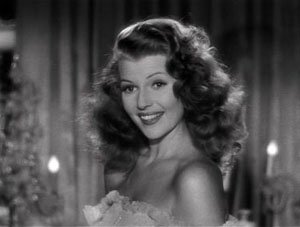
When we first meet Gilda she appears like a jack-in-the-box. Her head pops up in such a way that we can’t help but see the lush and luxurious hair and the smile that seems to suggest so much, like playful sex. Everything about Gilda is sex.
For her, it’s both weakness and strength.
We also know immediately, from Johnny’s reaction to Gilda, that “something’s going on there.” They know one another; there is a relationship between them, one that has clearly soured.
The movie is also about relationships that are off in some way. There is anger, even outright hate between Johnny and Gilda, especially on Johnny’s part. As much of a weasel he was in the film’s beginning (and still is, though he has cleaned up his act), he is equally unforgiving. Gilda, encountering his spite, responds in kind.
What we’re not quite sure of is the why of it all. (I don’t recall if this is ever explained other than the fact that Johnny left her, though reasons may be suggested.)
Perhaps what is really askew between Johnny and Gilda is that neither knows what they want. Johnny wants money and power, though I imagine he would be hard pressed to answer why (beyond getting out of the gutter). It seems to be a deflective desire, something pursued in order to forget.
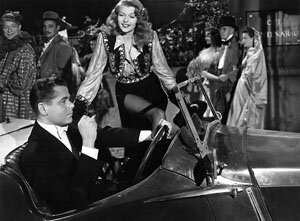
Gilda, on the other hand, hasn’t a clue what she wants. She is entirely reactive – to Johnny’s hate, to the men that use her, to her lack of purpose. (However she, as opposed to Johnny, begins to have an idea as the movie progresses.)
We, on the other hand, pretty much know what both want but won’t admit to themselves: each other. They live in a world of denial; neither wants to articulate the truth about their feelings.
Then there is Ballin Mundson (George Macready). Some argue there is a homoerotic element to Gilda in the relationship between Mundson and Johnny.
Given when the film was made and the shadow of the Hays Code, it would have been difficult to make something like that obvious so, initially, the argument may seem a bit of a stretch.
But the more you think about the movie the more it makes sense. Much of what happens in the film’s first half seems unlikely and arbitrary unless you see a homosexual element to it. One of the things that first struck me was how absurdly convenient it was that Johnny, in a shady part of town, is rescued from thieves by a wealthy man who just happened to be in that end of town. It makes sense, however, if he is in that part of town looking to pick someone up for sex.
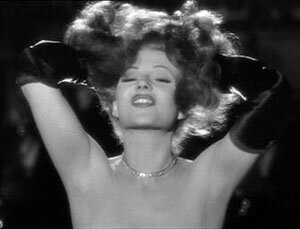
The relationship that develops between Johnny and Mundson makes more sense in this context.
Johnny’s taken into Mundson’s world, given a position of authority and trust, becomes his right hand man, given access to Mundson’s wealth (including the safe) … And it all happens very quickly.
It all seems a little too convenient unless you consider there is something like a gay relationship between the two (though not a healthy gay relationship). It gains credibility if you see the relationship of Johnny to Mundson as similar to Sunset Boulevard‘s Joe Gillis to Norma Desmond.
It also adds another element to Johnny’s dislike of Gilda: there is a previous relationship between them but there is also the fact that, with Gilda as Mundson’s new wife, she is intruding on Johnny’s position.
Though it may be a bit of a long shot as far as interpretations go, I like to think that homoerotic aspect is there. It helps make sense of what are otherwise puzzling story elements and also adds a nice bit of irony in that it is present in a movie known for its heterosexual quality, the “love goddess” Rita Hayworth, famous for making heterosexual men crazy with longing.
When you get past the glitz and spectacle of Rita Hayworth’s famous sultry sexuality in the movie, the more you can’t help thinking this is one crazy movie about abuse and aberrant psychology. And you know, despite the happy gloss of the ending, that it will continue. Johnny and Gilda may have mended their fences and be doe-eyed once again, but the abuse will be back.
(Note: Rita Hayworth and Glenn Ford would be teamed again six years later in 1952’s Affair in Trinidad, an attempt to jump start Rita’s career and a poor knock off of Gilda.)
Film noir doesn’t always mean good: Dark Passage
It’s Day 6 of For the Love of Film (Noir) — don’t forget to or use the button on the right. And if you are interested in boatloads of great links to musings on film noir and its films, scroll down this page at Self-Styled Siren or over at Ferdy on Films. This is wonderful material!
As much as I like movies in the film noir category, particularly those from the forties and fifties, the term is not a synonym for good. As with any type of movie — screwball, romance, western, drama — it has its clunkers.
Of course, everything is subjective. As you’ll read below, I don’t have a high opinion of Dark Passage. Maybe the problem isn’t the movie but me. To be fair, there is this review over at Noir of the Week. As for mine …
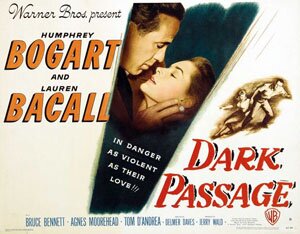 Dark Passage (1947)
Dark Passage (1947)
Directed by Delmer Daves
Of the four movies Humphrey Bogart and Lauren Bacall made together, Dark Passage is easily the weakest. (Their other movies together were To Have and Have Not, The Big Sleep, and Key Largo.) It’s a film noir that has what it thinks is a neat idea — the first third of the movie uses a “first-person” camera, meaning the central character is the camera viewpoint.
But it falls flat.
In fact, the gimmick pretty much ruins the film because we don’t get to see (and therefore connect with) Humphrey Bogart’s character. In the first third, we don’t see him period. He is the camera viewpoint. In the second third, his head is bandaged (due to plastic surgery to alter his identity).
We don’t actually see Bogie till a large chunk of the movie is over. By the time we do, we’re bored.
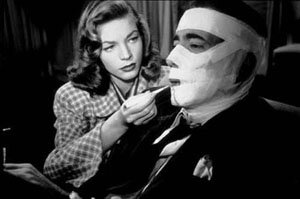 Bogart plays a character wrongly accused and convicted of murder. The movie opens with his escape. On the run, he is rescued by Lauren Bacall’s character. (Everyone Bogart runs into in the movie conveniently has some connection to the story.)
Bogart plays a character wrongly accused and convicted of murder. The movie opens with his escape. On the run, he is rescued by Lauren Bacall’s character. (Everyone Bogart runs into in the movie conveniently has some connection to the story.)
A helpful cab driver later recommends a shady plastic surgeon to Bogart’s character. Bogart gets his face changed then goes off in search of the criminals who framed him so he can prove his innocence.
Despite trying, the movie never gets very interesting. For one thing, there is very little to relieve the darkness of the noir approach. There is also little chemistry between Bogart and Bacall and this is largely because they play so few scenes together, at least in the first two thirds.
The characters do have scenes, but since Bogart isn’t physically in them (because of the camera viewpoint or because his head is wrapped in bandages and he can’t talk), the Bogie-Bacall magic is absent.
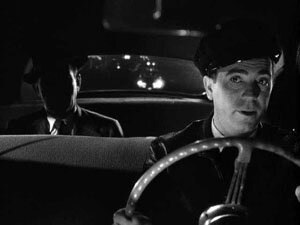 The other problem are the improbable conveniences mentioned above — the helpful cab driver, a guy who picks up Bogart when he is hitchhiking, Bacall’s appearance. It’s all a little too improbable.
The other problem are the improbable conveniences mentioned above — the helpful cab driver, a guy who picks up Bogart when he is hitchhiking, Bacall’s appearance. It’s all a little too improbable.
The only time we get a sense for an interesting story is at the very end when Bogart and Bacall have fled to South America. Suddenly the heavy handed noir atmosphere is relieved and we get something that has more of the atmosphere of Casablanca or To Have and Have Not.
It seems clear that the movie has misread what made Bogart and Bacall so interesting together. It certainly misreads Bogart.
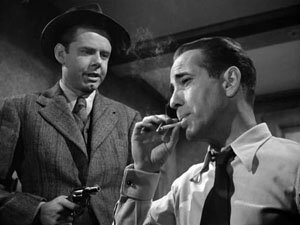 Despite the success of movies like The Big Sleep and The Maltese Falcon, it wasn’t the noir genre that made Bogart popular. It was that he was playing a flawed romantic hero within them.
Despite the success of movies like The Big Sleep and The Maltese Falcon, it wasn’t the noir genre that made Bogart popular. It was that he was playing a flawed romantic hero within them.
In Dark Passage he simply plays a schmuck floundering around trying to prove his innocence. He doesn’t play a strong character. If anything, the character is rather weak.
And so we end up with a tedious movie, one that relies on a gimmick rather than the power Bogart and Bacall could bring to the screen.
They are wasted in this movie.
On Amazon:
- Dark Passage
- Bogie and Bacall – The Signature Collection (includes: The Big Sleep, Dark Passage, Key Largo and To Have and Have Not)
Chinatown and the self-aware noir
It’s Day 5 of For the Love of Film (Noir) — don’t forget to or use the button on the right. And if you are interested in boatloads of great links to musings on film noir and its films, scroll down this page at Self-Styled Siren or over at Ferdy on Films. This is wonderful material! (Also see today’s Blogathon Notes.)
One of the few things I’m certain about with the movies that started this whole film noir business, movies from the forties and fifties like The Big Heat, Double Indemnity, or Gilda, is that they were not aware of themselves as being in a genre called film noir. They might have thought of themselves as B-movies, crime movies or pulp, but not film noir. Categorization like that always comes after the fact.
But once an approach or style is identified, like film noir, subsequent movies taking that approach are self-aware. They see themselves as film noir and inevitably try to replicate the approach. They may try to do much more, but they can’t be made the same way as the original film noirs were. Awareness affects what is being created.
Just as you can’t see the same movie twice (not in the same way), you can’t make the same kind of movie twice. But you can come damn close!
Chinatown (1974)
Directed by Roman Polanski
Chinatown, a wonderful movie, is an example of what a script can do for a film.
It’s like finding the right music at a party. Someone feels compelled to dance, then another and another. Soon, everyone’s up dancing. And dancing well.
In Chinatown, just about every artist is dancing their damnedest because the script has pulled them onto the floor. Director, actors, lighting people, costume designers … they’re all performing at their highest level.
It’s Robert Towne’s script that has done this.
One of Roman Polanski’s great talents is creating mood and few films do it so well and so quickly as the opening of Chinatown. I can’t think of many movies I would watch simply to see the opening credits but the look and the marvellous music of the introductory credit sequence is just so good with its period lettering and sepia tone (which carries through the movie), that you’re hooked even before the movie has presented its opening shot.
Modelling itself on the film noir style (particularly films like Howard Hawks’ movie The Big Sleep), the film’s mystery is created by presenting the story through the eyes of detective Jake Gittes, the Jack Nicholson character. We know what he knows, we’re puzzled by what he’s puzzled by, we’re misled by what misleads him. In fact, just as Bogart was in just about every scene of The Big Sleep, Nicholson is in just about every scene in Chinatown, either as a participant or as an observer.
But the film isn’t dependent on Nicholson. Faye Dunaway is perfectly cast as the enigmatic, and troubled, Evelyn Mulwray. It’s hard to imagine anyone else but Dunaway in that role. The movie is also bolstered by brilliant supporting performances, particularly John Huston as Noah Cross.
I also love the leisurely way the movie unfolds. Unlike the quick cuts and thrumming soundtrack of most current movies, Polanski takes his time. And it works so well. This may be the reason why it works. You’re seduced by the mood, and become involved with the characters, and thus the story.
Chinatown is a great, fascinating movie that illustrates the importance of beginning with a great script.
With the DVD … it’s okay. Not great, could be a lot better, but adequate. It’s largely clean and clear, but certainly not on the pristine level.
This is partly due to it being an older film (1974). For extras, there is really just one (I don’t count trailers as extras).
There is a documentary of sorts. It features interview clips with director Roman Polanski, writer Robert Towne, and producer Robert Evans.
There are some interesting comments, but there is really no depth to it … Par for the course with DVD extras.
(Note: This was written more than 10 years ago. The DVD comments refer to an early DVD release. The movie has since been released in a “special edition” which, I believe, is an improvement.)


